How and why are building managers using thermal imaging?
A thermal imaging survey is the quickest way to find out why your building is cold, often revealing problems that you wouldn’t find any other way. Using specialist infrared cameras, a standard survey will identify subtle differences in temperature – without even needing to enter a building. Once captured, the easy-to-interpret images can clearly highlight areas of concern, showing clients where they’re wasting energy and losing money.
Here are 7 reasons why building managers are starting to use thermal imaging as part of their facilities management strategy.
1. Reducing heat loss

Thermal image of a commercial building
A thermal imaging survey will accurately identify, capture, and assess heat loss within buildings. Knowing where heat is escaping from means those responsible can take steps to prevent further loss. This includes improving insulation and reducing air leakage.
These quick and non-disruptive inspections are the easiest way to demonstrate building compliance, and are invaluable for monitoring the effectiveness of heating and systems throughout a building.
This can be particularly important for:
- Vulnerable residents or employees
- Retail units and outlets
- Valuable stock items in storage
- Monitoring thermal comfort
In most circumstances, fixing the source of heat loss is more than likely to lead to a substantial reduction in both household and commercial energy bills.
2. Locating missing, damaged or inadequate insulation
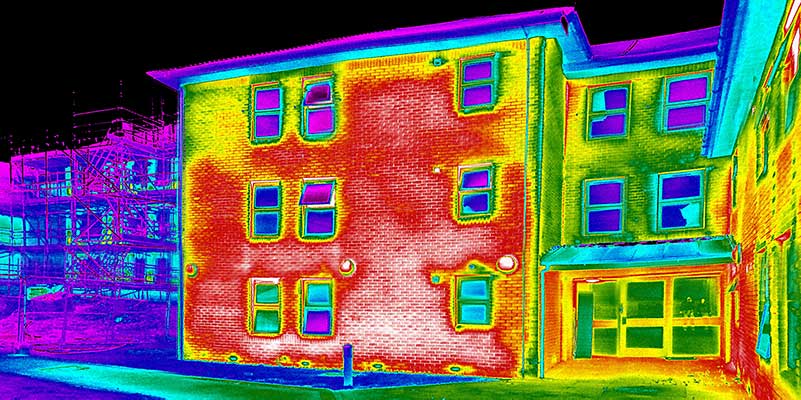
Damaged insulation in a building
Insulation is essential in keeping heat or cold from infiltrating a building, and has a large impact on energy efficiency. It’s therefore important to locate the areas where insulation may not be performing as it should.
Thermal imaging surveys locate areas where insulation is missing. A lack of insulation in a certain area could be due to:
- Design oversights
- The use of the wrong materials
- General building errors
All of these are important to an owner seeking financial redress for faulty work. This is particularly useful for resolving arguments and disagreements with sub-contractors.
Thermal surveys can also identify where there is damage to insulating materials. This could be because of an accident during construction, such as falling mortar, or after construction when the building is occupied. For example, wildlife can cause disturbance to insulation, and some materials may break down naturally over time.
3. Identifying air leakage
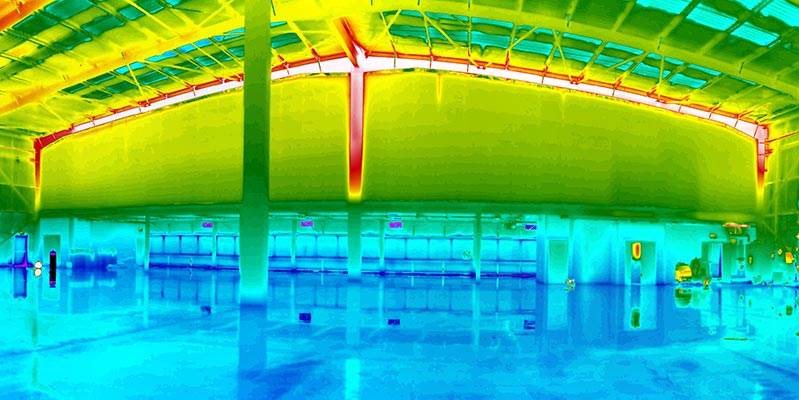
Heat escaping from a building rooftop
Air leakage is the unintentional intrusion of outside air into a building. This often occurs when cold air enters through cracks or holes in the building fabric. Significant air leakage has an impact on a building’s energy efficiency rating, so it’s important to fix these areas where air enters accidentally. Thermal surveys can accurately locate areas of infiltration, helping to improve ventilation and thermal comfort throughout a building, and of course, save on energy bills.
4. Checking for water ingress
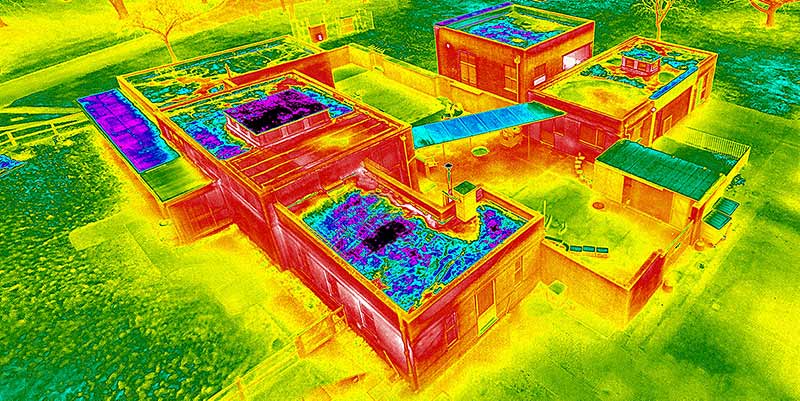
Water ingress found using a drone
Water ingress occurs when water from outside sources makes its way into a building. There are many ways that water can enter a building. The most common causes are damaged or deteriorating materials, which means that water is able to permeate through the roof or walls.
It’s important that buildings are watertight, as this prevents further deterioration of building materials, which otherwise can lead to costly repairs. The first step to fixing water ingress is to identify the source of intrusion, which may not always be visible to the naked eye. A thermal imaging survey can accurately locate where water penetrates the building materials. This allows property owners to resolve the water ingress before repairing any property damage, thereby minimising the cost of repair.
5. Pinpointing early condensation
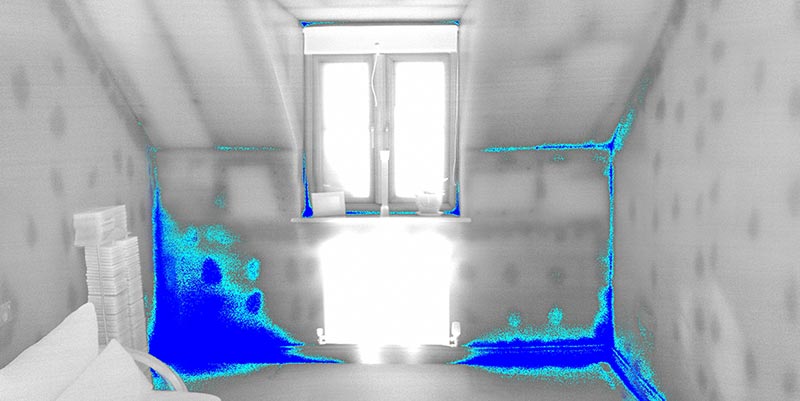
Damp ingress found using thermal indexing
Another issue that thermal surveys can help to prevent is condensation, which is the most common cause of damp in buildings. Condensation occurs when warm, moist air comes into contact with cold surfaces. This can create further issues, such as mould, staining, and damage to building fabrics. As such, condensation has a large impact on a building’s performance.
Inconsistent heating and poor ventilation are both common causes of condensation. This is because the air temperature in a building has a large impact on the amount of condensation that forms. Thermal imaging is a useful method for identifying areas of poor air flow and where damp emerges. This allows property owners to adopt methods that prevent condensation, before it develops.
6. Finding damp problems
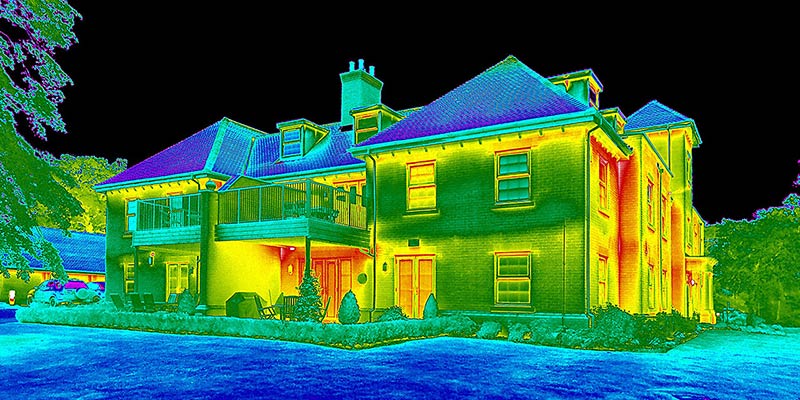
Thermal image from a residential building survey
Mould, also known as mildew, is a fungal growth caused by excess moisture. The issue affects both new and older buildings, and is not always visible. Exposure to mould can cause health issues such as nose and throat irritation, and may aggravate a range of existing health issues, including asthma and other respiratory problems. This is particularly important in today’s society, following the impact of Covid-19.
Generally, the existence of mould in a building is due to issues such as damp, as well as inadequate air flow. Fortunately, thermal imaging can provide an insight into a room’s temperature conditions, and is ideal for identifying where mould is likely to develop. This includes areas of excess moisture, often caused by leaking pipes. The results of a thermal imaging survey allow building managers to make the changes needed to prevent further mould growth, which can in turn help save money in the event of a compensation claim.
7. Assessing Thermal Comfort
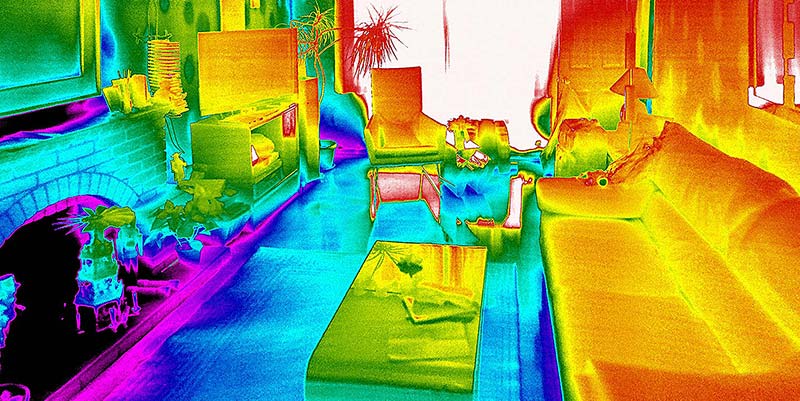
Poor thermal comfort in a residential building
In many cases, building owners have a very specific problem to investigate. For example, new window installations may be draughty or cold, and they need evidence of where and how this heat loss is happening.
Thermal comfort is related to the thermal environment within a building. If a person is content with their thermal environment, this means that they do not feel too hot or too cold. The human body is capable of detecting temperature differences as low as 1ºC, and whilst it’s difficult to define thermal comfort as an exact temperature (everyone’s different), there are legal temperature requirements in some public and commercial/industrial buildings.
When assessing thermal comfort, there are a range of factors that can have an impact. These include air temperature and velocity – with one example being draughts, which generally make people feel cold. Thermal imaging can identify many of the causes of thermal discomfort, such as air leakage, which allows property owners to make the improvements needed to increase comfort within a building.
Ready to book your thermal imaging survey?
Whether you’re a facilities management company looking to add thermal imaging to your suite of services, or a building manager wanting to find out why your building is cold – we’re here to help.
iRed® is the largest independent thermal imaging consultancy in the UK. As the preferred supplier for NHBC and leading home-builders nationwide, we can help you quickly see where you’re losing heat, and provide action steps to fix serious issues.


